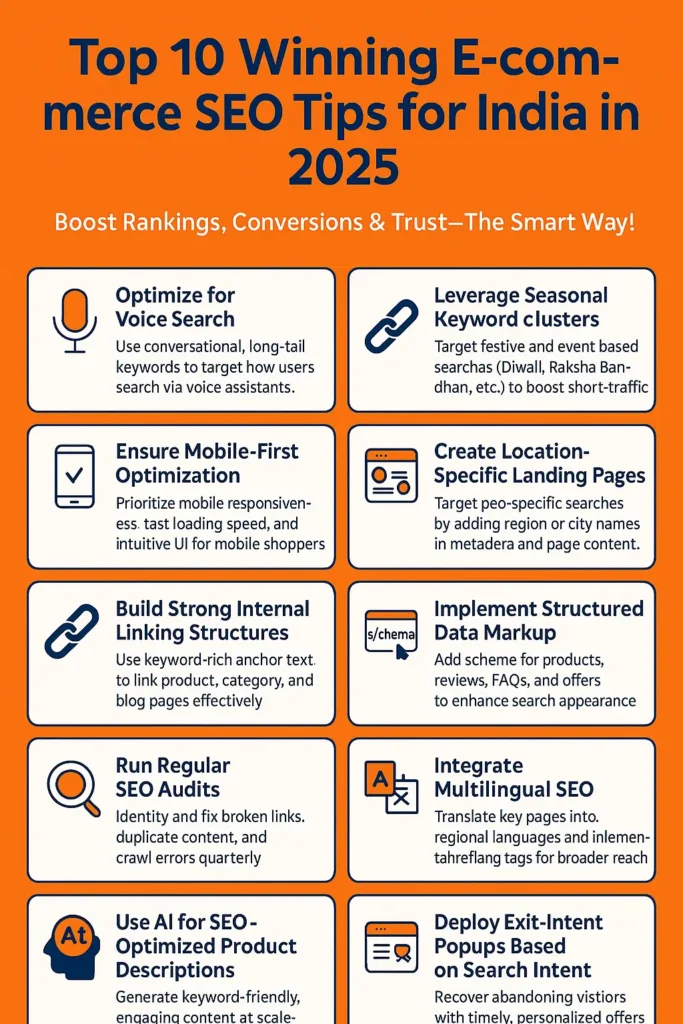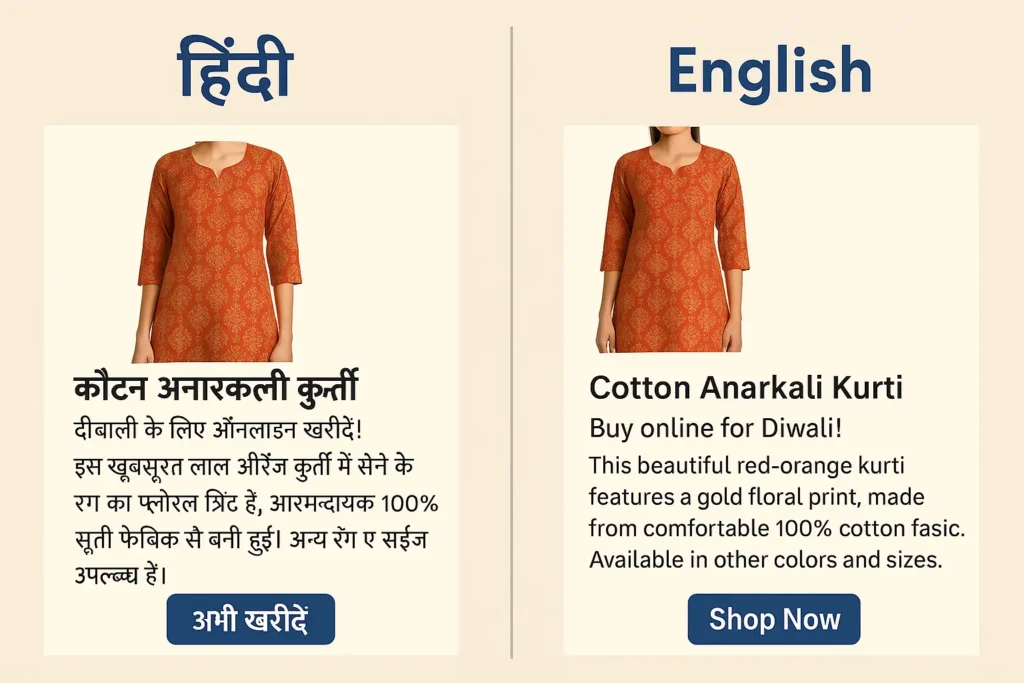
India’s e-commerce market is one of the fastest-growing in the world. With millions of online buyers from tier-1, tier-2, and tier-3 cities, there’s an enormous opportunity for growth. Yet, many e-commerce businesses are missing out simply because they haven’t optimized their SEO strategies. Why? Well, Why 80% of Indian E-commerce Sites Fail at Mobile SEO (And How to Fix It) — is something most businesses overlook.
If you’re looking for the best e-commerce SEO strategies India has to offer, this blog is your go-to roadmap. We’ve tailored it for small to mid-sized Indian businesses who need practical, budget-friendly, and powerful SEO plans to drive real sales.
Why SEO Still Wins in Indian E-commerce
Best E-commerce SEO Strategies India: Top Tips for Ranking & Conversions
Many e-commerce store owners focus heavily on paid ads. But SEO brings long-term returns and builds trust. Here’s how to align your SEO efforts to India’s buyer behavior and online search trends:
Top Tips for Ranking & Conversions in 2025:
- Optimize for Voice Search
Use conversational, long-tail keywords to target how users search via voice assistants. - Leverage Seasonal Keyword Clusters
Target festive and event-based searches (Diwali, Raksha Bandhan, etc.) to boost short-term traffic. - Ensure Mobile-First Optimization
Prioritize mobile responsiveness, fast loading speed, and intuitive UI for mobile shoppers. - Create Location-Specific Landing Pages
Target geo-specific searches by adding region or city names in metadata and page content. - Build Strong Internal Linking Structures
Use keyword-rich anchor text to link product, category, and blog pages effectively. - Implement Structured Data Markup
Add schema for products, reviews, FAQs, and offers to enhance search appearance. - Run Regular SEO Audits
Identify and fix broken links, duplicate content, and crawl errors quarterly. - Integrate Multilingual SEO
Translate key pages into regional languages and implement hreflang tags for broader reach. - Use AI for SEO-Optimized Product Descriptions
Generate keyword-friendly, engaging content at scale while keeping it human-centric. - Deploy Exit-Intent Popups Based on Search Intent
Recover abandoning visitors with timely, personalized offers that match their search queries.

Mobile SEO: The Silent Deal Breaker
More than 85% of e-commerce searches in India happen on smartphones. Yet, most online stores overlook mobile optimization.
Fixing Mobile SEO for Indian Online Stores (2025)
Core Web Vitals First
Focus on fast loading (LCP < 2.5s), quick interactivity (FID < 100ms), and visual stability (CLS < 0.1) for mobile.
Mobile-Optimized Images
Use compressed WebP images, lazy loading, and CDNs to boost mobile speed without hurting quality.
Structured Data for Mobile
Ensure product, review, and breadcrumb schema render correctly on mobile SERPs to enhance CTR.
Tap-Friendly Design
Use large, well-spaced buttons and visible navigation—especially for product categories and CTAs.
Mobile Keyword Targeting
Focus on voice search, short phrases, and location-based keywords like “buy shoes online India.”
Smooth Mobile Checkout
Enable UPI, wallet payments, autofill, and guest checkout to reduce cart abandonment.
Track Mobile SEO with GA4
Use Google Analytics 4 to monitor device-specific behavior, bounce rates, and cart drops.
Local SEO for Indian E-commerce Stores
Reaching customers in Surat, Patna or Kochi requires different tactics than reaching Delhi or Mumbai.
Tips to Win Local Searches:
Add your store to Google My Business with accurate info
List your business with complete NAP (Name, Address, Phone) details, timings, and images to appear in local map packs.
Example: “Chennai-based organic skincare store on GMB.”
Use local languages in product descriptions
Add regional language content to connect with non-English users and appear in local language queries.
Example: “मुलायम कॉटन साड़ी” (Hindi for soft cotton saree).
Use city + product keywords
Target hyperlocal search intent by combining city names with products.
Example: “Buy Cotton Kurtas Online Surat” or “Pune Furniture Store.”
Get listed in local directories
Register on India-specific platforms like Justdial, Sulekha, or IndiaMART for additional backlinks and trust signals.
Ensure consistent brand info across all directories.
Apply Local Schema Markup
Implement structured data (like LocalBusiness) to help Google display your store in relevant location-based searches and rich results.
Encourage customer reviews from locals
Request region-specific reviews to boost trust and CTR in local listings.
Example: “Fast delivery in Lucknow!”
Use city-based landing pages
Create dedicated pages for major locations you serve to rank higher in localized SERPs.
Example: “Best Online Grocery Store in Pune” page with city-specific content.
Affordable E-commerce SEO India: What Actually Works
Not every business can hire a top agency—and that’s okay.
Budget-Friendly DIY SEO Steps:
- Use Free SEO Tools for Audits & Fixes
Leverage tools like Google Search Console, Ubersuggest, and Screaming Frog (free version) to identify SEO issues like broken links, slow speed, or missing meta tags. - Optimize Title Tags & Meta Descriptions Yourself
Craft keyword-rich yet compelling titles and meta descriptions for every product/category page.
Example: “Buy Organic Spices Online India | Free Delivery & COD” - Do Manual Keyword Research Using Google Suggestions
Search your main product on Google and check autosuggestions and “People also ask” for long-tail keywords.
Example: Type “Buy sarees online” → suggestions like “under ₹500,” “in Chennai,” etc. - Compress Images & Use WebP Format
Use free tools like TinyPNG or Squoosh to reduce image sizes and switch to WebP to improve mobile speed — a key SEO factor. - Internal Linking to Boost SEO Flow
Link relevant blog posts, product pages, and FAQs to each other to increase dwell time and distribute SEO authority within your site. - Add Basic Schema Markup Using Free Plugins
Use plugins like Rank Math or Schema Pro to add structured data for products, reviews, and breadcrumbs — no coding required. - Write Your Own Blogs Using Targeted Long-Tail Keywords
Target informational search queries to pull in early-stage traffic.
Example: “Best sarees for summer weddings in India” - List Your Store on Free Local Directories
Create free listings on Google My Business, Justdial, IndiaMART, and Bing Places to improve local SEO for Indian e-commerce.
E-commerce SEO Tips for Small Businesses
Let’s break down SEO into things a small team can do weekly:
1. Target Long-Tail, Buyer-Intent Keywords
Use specific keywords like “Buy men’s cotton kurtas online India” instead of broad ones like “men’s kurtas.” These convert better and are easier to rank for.
2. Write Your Own Product Descriptions
Avoid copying manufacturer descriptions. Create unique, keyword-optimized content that highlights benefits, delivery, or local appeal (e.g., Cash on Delivery across Pune).
3. Use Local SEO to Your Advantage
Even if you’re online, target local traffic with terms like “Organic spices online Mumbai” and get listed on Google My Business for better local discovery.
4. Improve Website Speed for Mobile
Use lightweight themes, compress images, and enable caching to reduce mobile load times — essential for SEO and user retention in 2025.
5. Build Backlinks through Micro-Influencers & Local Blogs
Reach out to niche bloggers or regional influencers for guest posts or product mentions. These links boost authority and drive relevant traffic.
6. Focus on Category & Blog SEO
Your category and blog pages hold major SEO power. Use keywords like “Best wedding sarees online India” on these pages to capture high-intent traffic.
7. Add Product Reviews & Ratings
Encourage users to leave reviews. It improves trust, generates fresh content, and supports long-tail keyword ranking naturally.
8. Implement WhatsApp & Social Share Integration
Adding WhatsApp share buttons or product inquiries via WhatsApp boosts engagement and supports SEO indirectly by lowering bounce rates.
Hindi SEO: Reach 600M Users in Their Language

In 2025, targeting India’s massive Hindi-speaking population isn’t optional—it’s essential. Hindi SEO helps small and mid-size Indian e-commerce brands connect authentically, rank better regionally, and drive high-intent traffic. Only 10% of India’s population prefers English for online shopping. That leaves a massive audience searching in Hindi, Tamil, Telugu, and other languages.
How to Do It:
• Use Hinglish URLs & Slugs
Opt for URL formats like /kurtis-online-diwali-sale — easy to read, SEO-friendly, and naturally searched by users mixing English & Hindi online.
• Translate Titles & Descriptions with Local Flair
Include terms like “त्योहार कलेक्शन 2025” (Festive Collection 2025) in meta titles and product descriptions to boost visibility in Hindi searches.
• Apply Schema Markup in Hindi
Use JSON-LD schema to include structured data in Hindi for rich results like ratings, product names, and FAQs. This boosts SERP visibility for Hindi queries.
• Use Voice & Conversational Keywords
Optimize for phrases like “सस्ती शर्ट ऑनलाइन कहां मिलेगी” (Where can I get cheap shirts online?)—mirroring how users speak in voice search.
• Create Hindi Landing Pages & Blogs
Design dedicated category and offer pages in Hindi. E.g., “सिर्फ इस सप्ताह: दिवाली ऑफर – 50% छूट” can drive high click-through during seasonal spikes.
Why This Matters: While most websites still focus on English SEO, vernacular SEO—especially in Hindi—remains an untapped goldmine in Ecommerce SEO India. It drives better engagement, reduces bounce rate, and increases buyer confidence by speaking their language.
By implementing Hindi SEO in 2025, you’re not just improving rankings—you’re building deeper trust with the next 600 million internet users.
Festive Season SEO for Indian Sales

During Diwali or Rakhi, online search spikes. But most stores run generic sales, ignoring what people actually search for.
SEO Tactics That Work During Festivals:
- Target long-tail keywords (e.g., “affordable Diwali gifts under ₹499”)
- Build pages weeks in advance to get indexed
- Use Google Trends to identify surging product categories
AI-Powered Product Descriptions: Faster & Smarter
Writing hundreds of descriptions manually? It’s time-consuming and inconsistent. AI tools like Jasper or Writesonic can help.
Smart Tips:
- Use AI to draft product overviews
- Then edit with local context and slang for relatability
- Insert high-performing keywords naturally
This also makes SEO scalable for fast-growing brands.
Templates You Can Use: Free DIY Audit Tools
Many e-commerce business owners don’t audit their site regularly. Use this quick self-check list:
DIY SEO Audit Checklist:
- Page Speed: Test with Google PageSpeed.
- Meta Tags: Are they unique and keyword-rich?
- Mobile UX: Test across different screen sizes.
Tools:
- Screaming Frog for technical SEO
- Semrush or Ahrefs for backlink & keyword gap analysis
Online Shopping Trends in India: 2024 Outlook
- Tier-2 & 3 cities drive over 60% of growth
- Cash-on-delivery is still preferred for 50% of orders
- Search volume for regional products (e.g., Kolhapuri chappals, Assamese mekhela) rising
Use these insights to build seasonal product pages and target untapped areas.
FAQs
What are the best e-commerce SEO strategies in India in 2025?
Focus on mobile SEO, vernacular content, local optimization, and AI-powered content creation.
How can I do affordable e-commerce SEO in India?
Start with free tools like Google Search Console, optimize page speed, and target long-tail keywords.
How can I stay updated with online shopping trends in India?
Follow Flipkart & Amazon trend reports, Google Trends, and social commerce platforms like Meesho
What’s the best free tool for keyword research?
Ubersuggest, AnswerThePublic, and Google Keyword Planner are all great starts.
How soon can I see SEO results for my e-commerce store?
Usually 3 to 6 months, but quick wins (like local optimization) can show results in 4–6 weeks.
Should I focus on Hindi SEO or English?
Both. Use English for broader reach but integrate Hindi and regional content to connect with local audiences.



